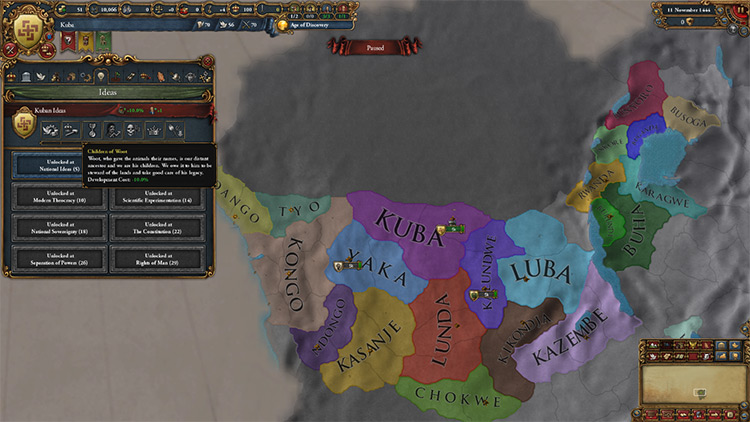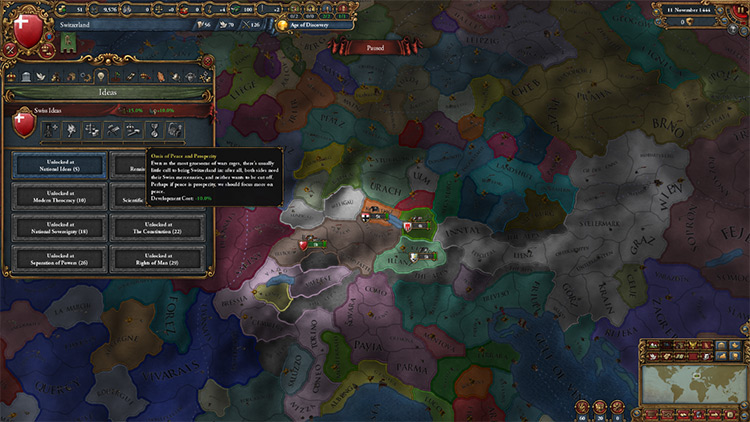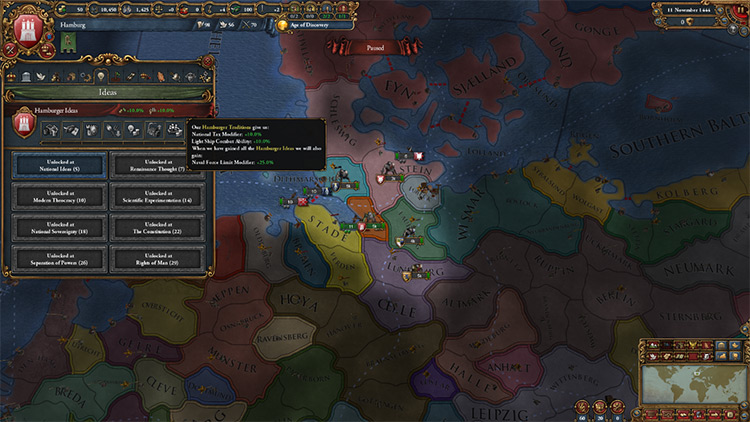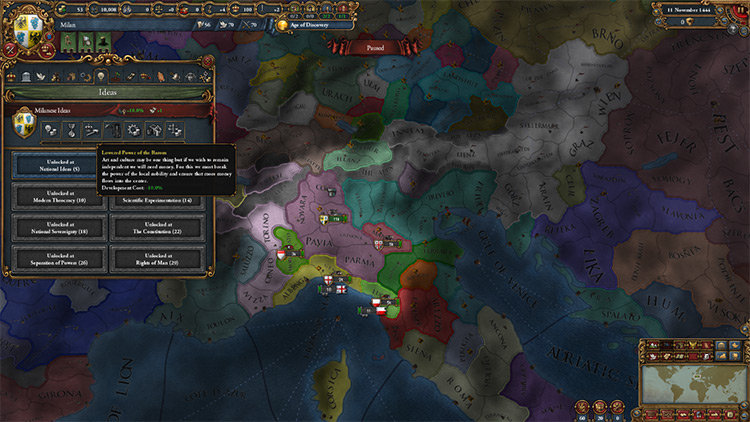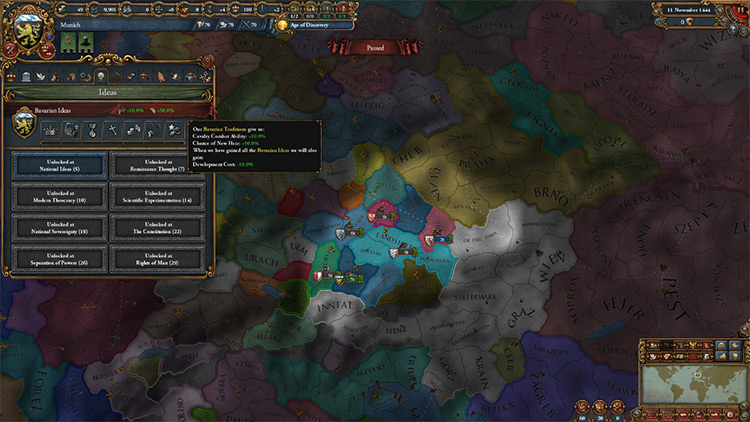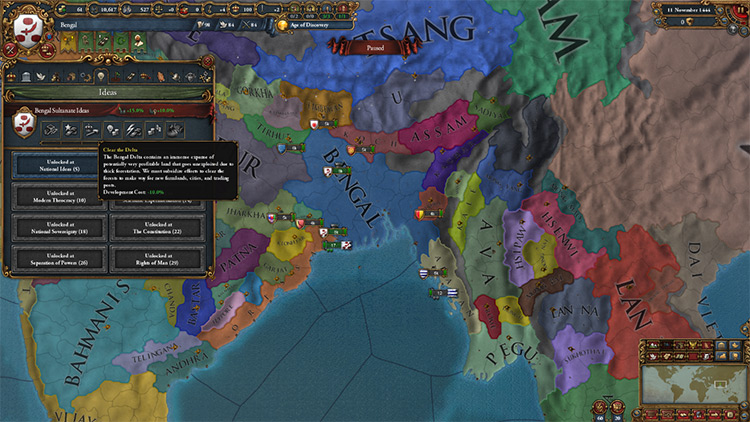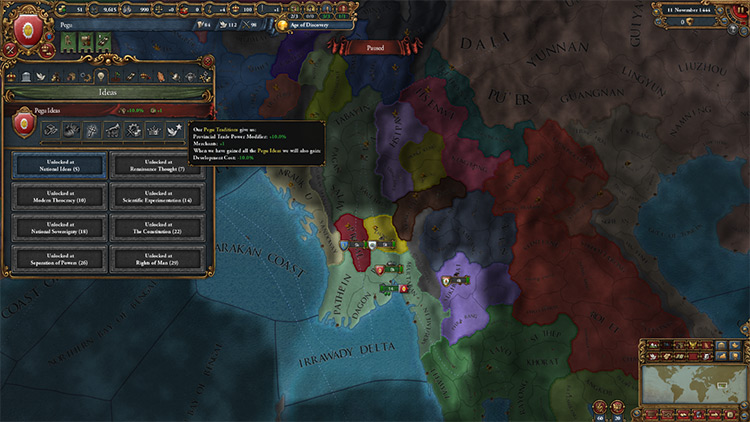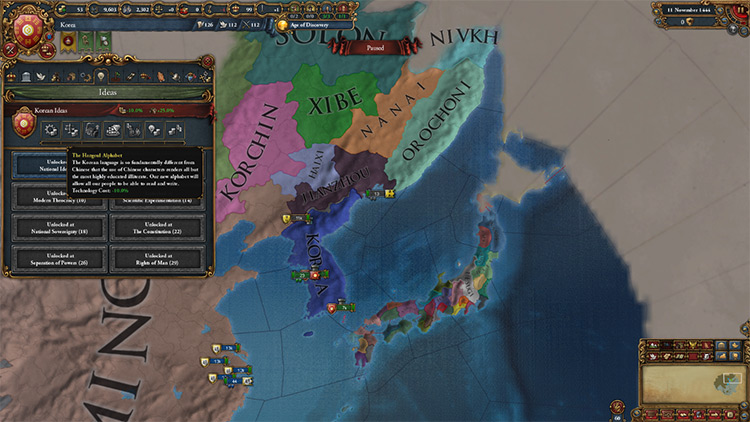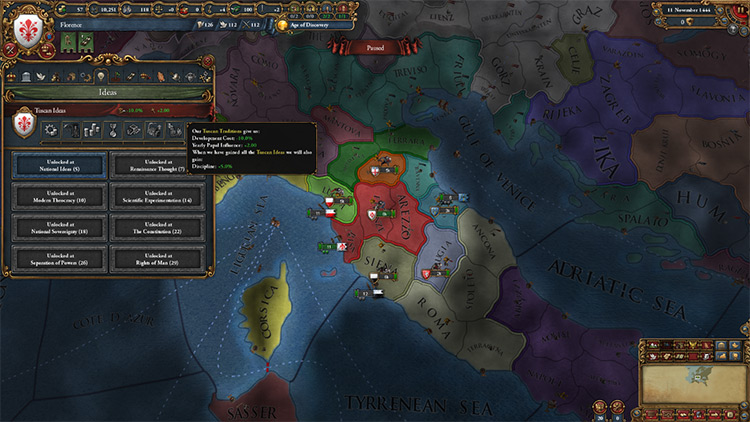What I deem as “tall” is having a compact, well-developed, and built-up powerbase. Conquering all of Indonesia as the Netherlands while controlling only the Low Countries in Europe falls inside the “tall” category in my opinion. As with all things in EU IV, some nations are better than others in playing tall. This can be due to a variety of reason, the main ones being their national ideas and mission trees. The single most important modifier you’re looking for is “development cost reduction”. You want to grab all the development cost reduction modifiers you can get your hands on. The easiest source of it is the economic idea group – so let’s check out which nations could be a strong fit for this.
10. Kuba
Kuba is an obscure nation in the Congo basin without any flavor to it, not in events nor in a unique mission tree. The nearby nation of Kongo is the only flavorful nation if you are looking to play in the area. Kuba, however, has a unique achievement tied to it, “Kuban Cigars”. This is reason enough for at least a campaign with the nation. Kuba’s ideas are nothing exceptional, except for the -10% development cost reduction they have. Get used to this modifier, you are going to see a lot of it in this article. On top of the boost from national ideas, Kuba also follows the fetishist faith. A faith that gives them access to an astonishing -20% development cost reduction if they discover the Buddhadharma cult. The native lands of the Kongo have surprisingly more grassland provinces than you may think. Kuba is also in an excellent position to corner the Ivory coast trade node and set up a trade empire across the seas. Keep the Kongo region as a power base (employ some vassals if you think it’s too much for a tall playthrough) and develop your lands while colonizing overseas. It makes for a fun chill campaign until you net the “Kuban Cigars” achievement.
9. Switzerland
Switzerland isn’t the first place that comes to mind when one mentions tall gameplay. In a tall campaign, you’re generally looking for farmlands and grasslands – good terrain you can develop without any maluses. Well Switzerland’s core land is actually 30% grasslands! The rest of the mountainous terrain offers a great way to protect yourself against aspiring invaders. The Swiss get a -10% development cost reduction in their national ideas. Their compact mission tree gives you some flavor along with the various events associated with the country. As a member of the HRE, when the emperor passes the first reform, you’ll enjoy a further -5% development cost reduction as long as you remain in the empire. Switzerland offers an alternative to the typical tall gameplay in flat terrain. Certainly, a unique experience. And Switzerland’s achievement “Switzerlake” has you conquering 99 provinces; however, you can always do that in the late game after a relaxing tall campaign in your mountains!
8. Hamburg
Hamburg begins the game as a free city in the HRE. Controlling one of the best provinces in Europe, the free city of Hamburg finds itself in a perfect position for a tall campaign. As all free cities, Hamburg enjoys a passive -10% development cost reduction, along with the -5% all HRE members enjoy after the first reform passes. Hamburg doesn’t get development cost reduction from its national ideas. Its ideas are excellent for setting up an overseas trade empire. And it is possible to do a successful Hamburg campaign without conquering a single province! Employ vassals, keep them happy, and develop your single province to insane levels. Hamburg also has a unique achievement, “Bunte Kuh”, which is one of my very favorites. It’s perfect to teach yourself how the game’s trade system works. If you want, you can always conquer the Low Saxon lands (less than a dozen provinces) and form the nation of Hannover. Hannover has a -10% development cost reduction in its national ideas, which will replace the one you lost when you ceased being a free city.
7. Milan
Milan is one of the many Italian states, all of which can claim to be powerful well-developed mid-sized nations. Many of these have the tools necessary to play tall, but I have to single out a couple of them. Milan, standing at the shadow of the Alps, starts with three farmlands provinces and natural defenses to its north. Its national ideas provide it with -10% development cost reduction and further reductions to idea and technology costs, which saves you monarch points to invest in development. Milan’s geographical location means you’ll never be too far away from the early institution spawns. You also have the flexibility of choosing between a unique republican government and a standard monarchy through an early game disaster. Variety is always welcome, as you can tailor the gameplay to what you enjoy most. And eventually unifying the peninsula and forming Italy can be a great transition to a campaign where you achieve dominance in the Mediterranean.
6. Bavaria
Bavaria might come as a surprise to many; it’s a hidden gem with untapped potential. The three Bavarian principalities all have Bavarian ideas, and can quickly unite the area and form the nation of Bavaria. This idea set provides the typical -10% development cost, with some good all-around bonuses on top. As a member of the HRE you also get to enjoy the passive -5% development cost from the first reform. The Bavarian mission tree sends you in a path of consolidation, development of the Bavarian heartland, and eventual election to the HRE imperial throne. In this mission tree lies a bonus of -10% development cost for your capital. Also, the lands in and arounds Bavaria are excellent for development, mostly farmlands and grasslands. Build up a strong powerbase in the German south and lead the Empire from there! The unique Bavarian achievement will send you down an eventual path of conquest, but this can always wait until the late game.
5. Holland/Netherlands
The Netherlands embodies the archetypal tall experience. Sandwiched between stronger realms, you’re forced to make do with little land. This land, in the Dutch case, happens to be one of the richest in the world. I decided against putting the Netherlands higher on the list because many do not consider colonization part of tall gameplay. You miss out on a lot if you don’t colonize as the Netherlands. In any case, the Dutch ideas available to the starting nation of Holland and later to a unified Netherlands offer the typical -10% development cost, along with excellent bonuses to trade and your navy. They scream “build a trade empire”. Setting up shop in strategic provinces along the African coast to steer the spice trade into the Channel is how a typical Netherlands campaign goes. Balancing your diplomacy between France and the HRE will dominate your European affairs. The flatlands can be a pain to defend against a strong France. The Dutch mission tree has you conquering Ceylon, Taiwan, and the entirety of Indonesia while also putting you up against the British across the Channel. A campaign that all EU IV players must play at least once.
4. Bengal
When thinking tall, India isn’t really a place one considers. Well, it may come as a surprise to many, but there are a lot of Indian nations with national ideas that fit a tall playstyle. Bengal is one of these, and the one that stands out the most. First things first: Bengal is a nation with flavor to it, enjoying an extensive mission tree and some events as well. In this mission tree lies a reward that gives most of your core land a -10% development cost. Bengal, being an Indian nation, has access to the Jain estate which can give you another -5% development cost. The Bengali national ideas also give a -10% development cost, while a good percentage of your land is farmlands. The Bengali mission tree has you expanding quite a bit, but that doesn’t mean you can’t still play tall or at least tall-ish. Being Muslim, you can also enjoy another -10% development cost if you invite a Maliki scholar. My recommendation for a Bengal campaign is to make extensive use of its tools for tall gameplay, while slowly expanding north along the Ganges. Most of the land you will be expanding into will be farmlands – all of this culminating with the capture of Samarkand and the unique achievement “Bengal Tiger”.
3. Pegu
Pegu is a nation designed to play tall – or at the very least, a good nation to make use of the game’s mechanics that enable this playstyle. Your start with five provinces, two of which are home to great projects. Both provide good bonuses, with the one in Dagon giving a local -10% development cost for the province. Pegu has a -10% development cost in its national ideas, like most nations in this list. The “tropical city planning” privilege of the merchant guilds alleviates the malus of tropical climate that your provinces will suffer from. It also has access to the Mandala government, which allows for concentration of development at no loss. In fact, by moving your capital periodically, you can reach 30+ development in many of your provinces without ever pressing the develop buttons. Pegu’s mission tree is one of the most unique in the game and a favorite of mine. It encourages minimal expansion to your north and west, while vassalizing the nearby Thai states, renaming them to their traditional Mon names in the process. This gameplay centered around strong vassals while you control a small super developed power base is the definition of tall play. As an eastern religion nation, you have access to the “inwards perfection” estate privilege giving potentially up to -33% development cost. With two unique achievements, I highly recommend giving Pegu a try.
2. Korea
Korea’s case is unique, as it doesn’t have the typical development cost reduction in its idea set. Instead, Korea enjoys a massive -10% idea and technology cost. This huge reduction saves you a ton of monarch points that can then be repurposed for province development. Korea’s mission tree leads you down a war path to conquer China, Japan, and Manchuria, while also containing missions centered around the development of your Korean heartlands. In my opinion, a tall start with an explosive mid to late game is the way to go. Korea follows the Confucian faith, providing another -10% development cost reduction at full harmony. On top of that, following an eastern religion, Korea has access to the “inwards perfection” estate privilege for another huge development cost reduction (up to -33%). In fact, Korea begins the game with the privilege already granted. Your starting ruler is godlike, allowing prosperity to build up in your provinces very quickly. Prosperous states enjoy another -10% development cost. With correct planning, you can easily develop provinces for dirt cheap even in the 15th century. The mountains to your north make for an excellent defensive line, while your national ideas make your navy a force to be reckoned. Korea wasn’t called the Hermit Kingdom for no reason. Bide your time behind your mountains, build up your nation, and strike when the time is right to settle once and for all the Sino-Japanese rivalry – likely by showing both who’s the real boss!
1. Florence/Tuscany
The Tuscan lands are the epitome of tall gameplay. All three starting Tuscan nations have development cost reduction in their ideas, and all three can form Tuscany eventually. Florence starts with the Tuscan idea set and mission tree. This idea set is perfect for playing tall. The -10% development cost paired with a -5% cost to technology and ideas will save you lots of monarch points throughout the game. The Tuscan location, as discussed earlier in Milan’s entry, is perfect to ensure all institutions reach you quickly. Situated in the Genoa trade node (one of the three end nodes in the game), the five Tuscan provinces contain 3 out of the 9 Centers of Trade in the node. The three coastal provinces are farmlands, while the hilly city of Firenze can comfortably protect all the land with a single fort. Firenze also has a great project already built up to tier 2 and a whopping 28 development from the start. This area of Tuscany is the single best area in the game overall. It has 91 starting development in 5 excellent provinces! The city of Lucca has a Center of Trade, farmlands terrain, and produces cloth, making it the most cost-efficient province to develop in the entire game. Also, the small and flavorful Tuscan mission tree encourages this style of gameplay, while giving you the necessary claims to form Italy. With a unique achievement tied to Florence, I recommend this campaign to anyone – regardless of how much they enjoy playing tall.
